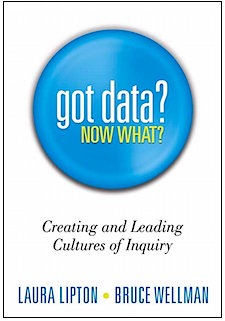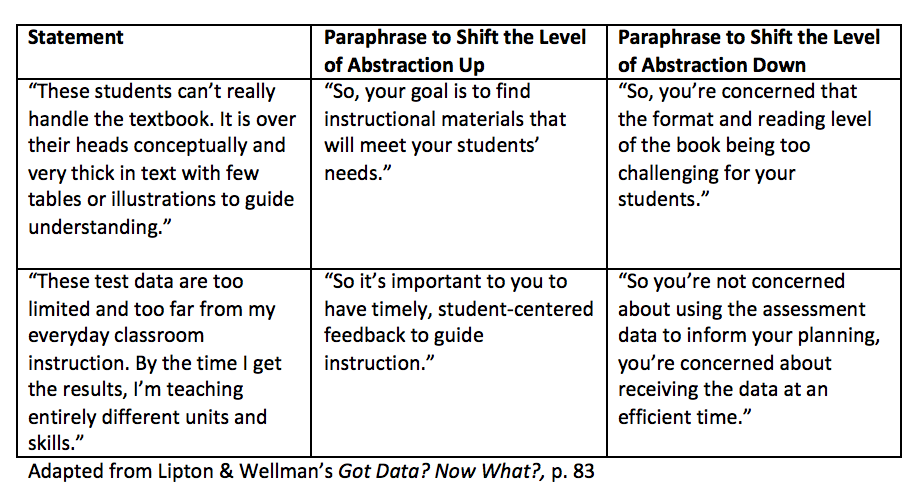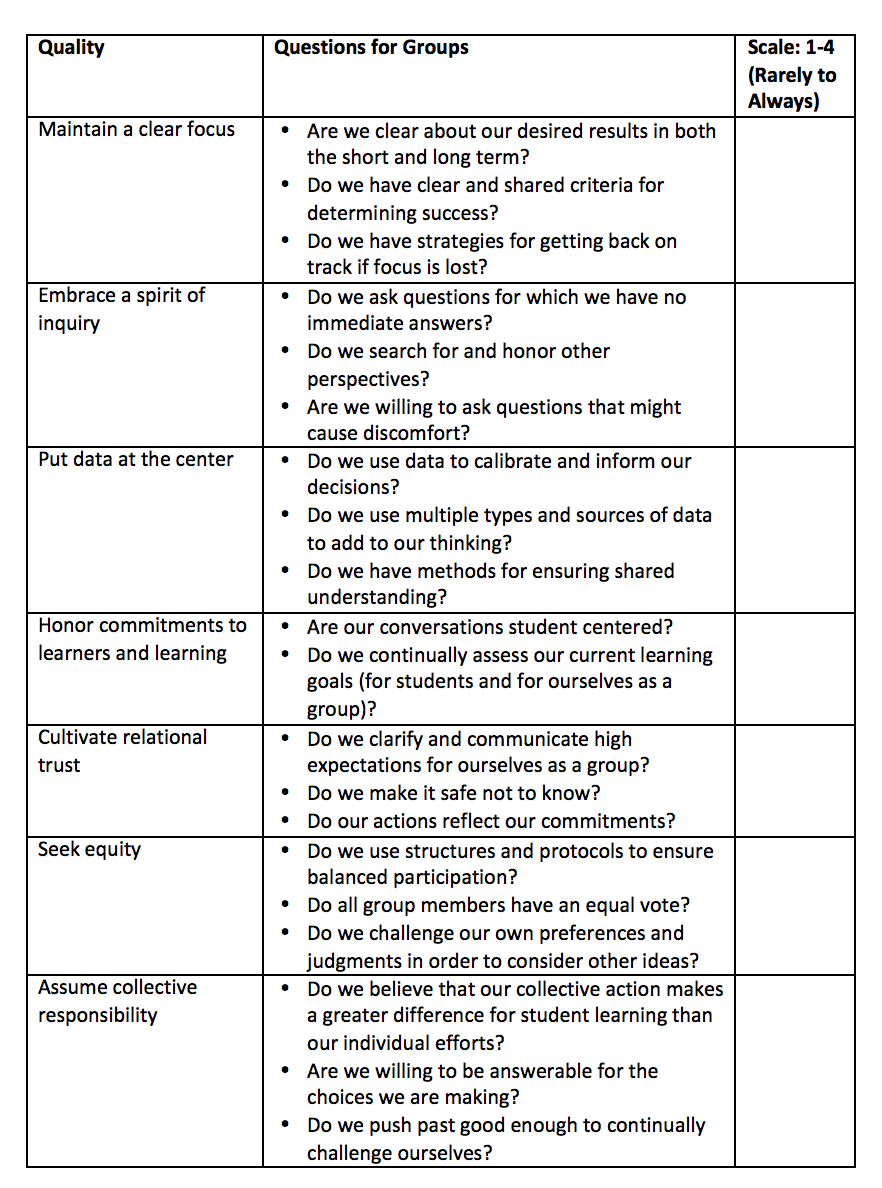“Collaborative inquiry is a value as much as it is a skill set.”
— Laura Lipton & Bruce Wellman in Got Data? Now What?
Reading that statement in the introduction to Got Data? Now What? Creating and Leading Cultures of Inquiry I simultaneously nodded and took a deep breath. The authors are experts in facilitation and working with groups, so it was only natural that I turned to their expertise as I prepared to work with a group of nine districts on making vertical teams more integral to continuous professional learning.
“Okay,” I thought. “I know how to help people develop the skills to work successfully in groups…but how do I help people make collaborative inquiry something they value and embrace?”
 Lipton and Wellman partially answered my question in their first pages:
Lipton and Wellman partially answered my question in their first pages:
Collaborative inquiry is a value as much as it is a skill set. Its true value emerges from the daily disciplines of practice, persistence, and attention to process. Skilled data use influences group development, and simultaneously, group development influences skilled data use. Patient and thoughtful groups learn to trust the process, their data, and one another (p. 3).
The authors include a lot of actions and behaviors in that one short paragraph. What became clear as I continued reading the book is that effective collaborative inquiry is a long-term process that requires commitment, patience, and a risk-free environment.
An essential teaming resource
If you are involved in a grade-level, vertical, or any type of team working on instructional improvement, this 2012 book from Solution Tree is a must-read.
In addition to an introduction and seven chapters, the authors include a rich selection of tables and charts – all reproducible both by copying from the book or by logging on to the authors’ page on the Solution Tree website (register to download the resources without charge).
As teams begin their joint enterprise, Lipton and Wellman suggest spending time explicitly discussing the purpose of the work and the way they will work together. Effective teaming involves making four value shifts that can help ensure success (p. 8).
 Lipton and Wellman don’t mince words when emphasizing the importance of the first shift: collaborative practice.
Lipton and Wellman don’t mince words when emphasizing the importance of the first shift: collaborative practice.
In cultures of high professional autonomy, the dominant values are entitlement and individualism. A strong belief in privacy translates to closed doors, protection of turf, and a perspective that data reflect personal success or failure…Teachers working in schools where this value is strong operate in isolation from one another, holding on to all of their personal strengths and weaknesses inside their private domains (pp. 7-8).
Shifting to a culture of collaborative practice requires teachers to embrace the reality that they learn best with others. Effective collaborative groups work together in a variety of ways: identifying problems of practice, developing common assessments, and discussing the results while being frank and candid about what worked and what didn’t. According to the authors, effective groups are “engaged in systematic and ongoing experimentation and (they) analyze data to learn from and with their students and colleagues.”
As I considered writing this blog post, I realized the need for selectivity. Otherwise this post would be almost as long as the book! So, I offer to you Cathy’s “Top Hits” from the book.
Top Hit One: The 7 Qualities Describing High Performing Groups
If you are joining a group, certainly you want to know that your time will be well spent and productive. Lipton and Wellman suggest that high performing groups tend to practice seven important behaviors/actions.
They offer a helpful table that groups can use to discuss and assess where they currently stand related to the seven qualities (pp. 11-12):
Top Hit #2: The Collaborative Learning Cycle
Three important steps comprise the Collaborative Learning Cycle: Activating and Engaging; Exploring and Discovering; and Organizing and Integrating. Each of the steps requires specific knowledge, skills, and dispositions. And, four actions govern the entire process: Managing, Modeling, Mediating, and Mentoring.
 As an example, the Activating and Engaging phase involves team members in surfacing both their experiences and expectations. The following questions should be posed to start the dialogue (p. 26):
As an example, the Activating and Engaging phase involves team members in surfacing both their experiences and expectations. The following questions should be posed to start the dialogue (p. 26):
- What assumptions do we bring to this discussion?
- What questions are we asking?
- What are some possibilities for learning that this experience presents to us?
The Exploring and Discovering phase is the time when team members analyze the data and consider questions like: “What important points seem to pop out?” and “What patterns, categories, or trends are emerging?”
The final phase, Organizing and Integrating, involves generating theory, where the team surfaces inferences, considers whether additional data sources might be needed, and begins to explore solutions.
The Collaborative Learning Cycle is recursive and invites team members to proceed slowly and deliberatively, with the willingness to step back or loop back if necessary.
Top Hit #3: Skills for Talking About Data
To prepare for discussing data, group members need to hone their skills in four different areas (p. 80):
- Listening without judgment
- Pausing to create space for thinking
- Paraphrasing to support relationships, increase understanding, and mediate thinking
- Inquiring to focus and open our thinking
These skills are essential to effective coaching and conversations about teaching practice. And my colleague Jackie Walsh would certainly endorse the second bullet, which suggests providing for both Think Time 1 and Think Time 2!
As I read this section, it became even clearer why paraphrasing is such an important skill. In addition to ensuring the listener (and group) is clear about what is being said, paraphrasing can be used to summarize and organize. It can also be used to “shift the level of abstraction up” or down (p. 81). The authors use the same two statements to explain these two shifts.
 A compact, powerful read
A compact, powerful read
The top hits could continue, but I’ll stop with three. And, I’ll suggest that you might want to add this book to your summer reading list. It is a short read—the entire book is 123 pages and includes an abundance of tables.
If you are a member of a school team, or if you are an administrator or instructional coach facilitating or supporting such teams, this is your go-to book as you work to create high-performing collaborative groups that will truly make a difference in teaching and learning.



0 Comments on "Got Data? Now You Need to Cultivate Collaborative Teams"